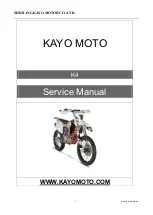
6 - 149
CHAS
REAR SHOCK ABSORBER
HANDLING NOTE
WARNING
This rear shock absorber is pro-
vided with a separate type tank
filled with high-pressure nitrogen
gas. To prevent the danger of
explosion, read and understand
the following information before
handling the shock absorber.
The manufacturer can not be held
responsible for property damage
or personal injury that may result
from improper handling.
1.
Never tamper or attempt to
disassemble the cylinder or
the tank.
2.
Never throw the rear shock
absorber into an open flame
or other high heat. The rear
shock absorber may explode
as a result of nitrogen gas
expansion and/or damage to
the hose.
3.
Be careful not to damage any
part of the gas tank. A dam-
aged gas tank will impair the
damping performance or
cause a malfunction.
4.
Take care not to scratch the
contact surface of the piston
rod with the cylinder; or oil
could leak out.
5.
Never attempt to remove the
plug at the bottom of the nitro-
gen gas tank. It is very danger-
ous to remove the plug.
6.
When scrapping the rear
shock absorber, follow the
instructions on disposal.
NOTES ON DISPOSAL
(YAMAHA DEALERS ONLY)
Before disposing the rear shock
absorber, be sure to extract the nitro-
gen gas from valve
1
. Wear eye
protection to prevent eye damage
from escaping gas and/or metal
chips.
WARNING
To dispose of a damaged or worn-
out rear shock absorber, take the
unit to your Yamaha dealer for this
disposal procedure.
REMARQUES CONCERNANT LA
MANIPULATION
AVERTISSEMENT
Cet amortisseur arrière est équipé
d’un réservoir indépendant contenant
de l’azote sous haute pression. Afin
d’éviter tout danger d’explosion, lire
attentivement les informations ci-des-
sous avant de manipuler l’amortisseur
arrière.
Le fabricant décline toute responsabi-
lité pour les dommages matériels ou
corporels résultant d’une mauvaise
manipulation.
1.
Ne jamais essayer de démonter le
cylindre ou le réservoir.
2.
Ne jamais jeter un amortisseur
usagé au feu ou l’exposer à une
chaleur intense. L’amortisseur
arrière risque d’exploser en rai-
son de la dilatation de l’azote et/
ou de l’endommagement de la
durit.
3.
Veiller à n’endommager aucune
partie du réservoir de gaz. Un
réservoir endommagé affectera la
capacité
d’amortissement ou
entraînera un mauvais fonction-
nement.
4.
Veiller à ne pas rayer la surface
de contact de la tige de piston
avec le cylindre afin d’éviter tout
risque de fuite d’huile.
5.
Ne jamais essayer d’enlever le
bouchon du fond du réservoir
d’azote. Il est très dangereux
d’enlever ce bouchon.
6.
Pour la mise au rebut de l’amor-
tisseur, suivre les instructions spé-
cifiques.
REMARQUES CONCERNANT LA
MISE AU REBUT
(CONCESSIONNAIRES YAMAHA
UNIQUEMENT)
Avant de mettre l’amortisseur arrière au
rebut, ne pas oublier d’évacuer l’azote
par la soupape
1
. Mettre des lunettes
pour se protéger du gaz et/ou des parti-
cules de métal susceptibles de s’échap-
per.
AVERTISSEMENT
Confier la mise au rebut d’un amortis-
seur endommagé ou usé à un conces-
sionnaire Yamaha.
AMORTISSEUR ARRIERE
Summary of Contents for wr250f
Page 51: ...1 26 GEN INFO MEMO ...
Page 89: ...1 64 GEN INFO MEMO ...
Page 189: ...2 96 SPEC MEMO ...
Page 285: ...3 74 INSP ADJ MEMO ...
Page 379: ...4 20 TUN MEMO ...
Page 831: ...7 10 ELEC MEMO ...
Page 847: ...7 26 ELEC MEMO ...
Page 869: ...7 48 ELEC MEMO ...
Page 877: ...7 56 ELEC MEMO ...
Page 893: ...7 72 ELEC MEMO ...
Page 903: ...7 82 ELEC MEMO ...
Page 910: ......
Page 911: ......
















































